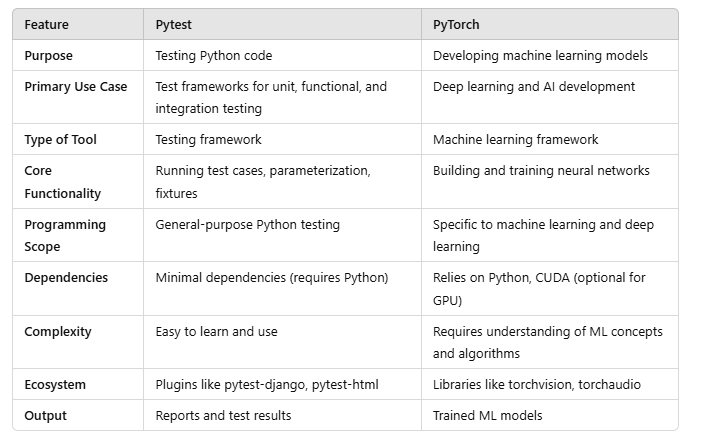What is Pytest and PyTorch? Major use cases and Differences.
What is Pytest and PyTorch? Major use cases and Differences.
Pytest and PyTorch: An Overview
Pytest: A testing framework for Python that simplifies writing, organizing, and running tests for Python code. It is widely used for unit testing, functional testing, and integration testing.
PyTorch: An open-source machine learning framework designed for building and training neural networks. It is particularly popular for deep learning and research-oriented tasks.
Major Use Cases
Pytest:
Unit Testing:
- Testing individual functions, methods, or components to ensure they work as expected.
- Example: Validating that a function correctly computes a sum.
Functional and Integration Testing:
- Ensures that multiple components of a system work together seamlessly.
- Example: Testing an API endpoint to verify it integrates with a database.
Parameterization:
- Easily run a single test function with multiple sets of inputs and expected outputs.
- Example: Testing a function for edge cases using different data inputs.
Test Discovery:
- Automatically discovers and runs test cases in a project.
Fixtures for Test Setup:
- Provides reusable and modular fixtures for test setup, such as creating mock objects or temporary files.
Custom Plugins and Extensions:
- Supports plugins for enhanced capabilities like HTML reporting, coverage analysis, or parallel testing.
PyTorch:
Deep Learning Model Development:
- Building, training, and fine-tuning neural networks for tasks like image recognition, NLP, and speech processing.
Research and Prototyping:
- Used by researchers for quick prototyping of experimental models due to its flexibility and dynamic computation graph.
Computer Vision:
- Tasks like image classification, object detection, and image segmentation using PyTorch libraries like
torchvision.
- Tasks like image classification, object detection, and image segmentation using PyTorch libraries like
Natural Language Processing (NLP):
- Building models for tasks like sentiment analysis, machine translation, and language generation.
Reinforcement Learning:
- Leveraged for training agents to perform tasks in simulated environments.
Production Deployment:
- Export trained models to production environments using tools like TorchScript or ONNX.
Key Differences

Example: Pytest
# test_example.py
import pytest
def add(a, b):
return a + b
@pytest.mark.parametrize("a, b, expected", [
(1, 2, 3),
(0, 0, 0),
(-1, -2, -3),
])
def test_add(a, b, expected):
assert add(a, b) == expectedCommand to Run Tests:
pytest test_example.pyExample: PyTorch
import torch
import torch.nn as nn
# Define a simple neural network
class SimpleNN(nn.Module):
def __init__(self):
super(SimpleNN, self).__init__()
self.fc = nn.Linear(2, 1)
def forward(self, x):
return self.fc(x)
# Create the model, define a loss function and optimizer
model = SimpleNN()
criterion = nn.MSELoss()
optimizer = torch.optim.SGD(model.parameters(), lr=0.01)
# Dummy data
inputs = torch.tensor([[1.0, 2.0], [3.0, 4.0]])
targets = torch.tensor([[3.0], [7.0]])
# Training loop
for epoch in range(100):
optimizer.zero_grad()
outputs = model(inputs)
loss = criterion(outputs, targets)
loss.backward()
optimizer.step()
print(f"Trained model predictions: {model(inputs).detach().numpy()}")Conclusion

While Pytest ensures your Python application works flawlessly, PyTorch helps build intelligent systems. Both tools serve distinct domains and are equally important depending on your project needs.